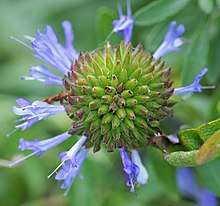Salvia clevelandii
Salvia clevelandii, the fragrant sage,[1] blue sage, Jim sage and Cleveland sage, is a perennial plant that is native to Southern California and northern Baja California, growing below 900 m (3,000 ft) elevation in California coastal sage and chaparral habitat. The plant was named in 1874 by Asa Gray, honoring plant collector Daniel Cleveland.[2][3]
| Salvia clevelandii | |
|---|---|
 | |
| Scientific classification | |
| Kingdom: | Plantae |
| Clade: | Tracheophytes |
| Clade: | Angiosperms |
| Clade: | Eudicots |
| Clade: | Asterids |
| Order: | Lamiales |
| Family: | Lamiaceae |
| Genus: | Salvia |
| Species: | S. clevelandii |
| Binomial name | |
| Salvia clevelandii | |

Description

Salvia clevelandii is an evergreen shrub that reaches 1 to 1.5 m (3.3 to 4.9 ft) in height and width. The fragrant, ashy green leaves are obovate and rugose, growing less than 2.5 cm (0.98 in) long. Flowers are on 30 cm (12 in) spikes, with numerous whorls of upright amethyst blooms opening in June–July.[2]
Cultivation
Salvia clevelandii is a popular Southwest USA landscape plant, cultivated since the 1940s. Plants prefer dry summers, good drainage, and tolerate full sun in cooler areas. As a landscape plant they have a relatively short life span of five to ten years. They are hardy to −7 °C (19 °F).
Cultivars and hybrids include:
- 'Winnifred Gilman', a popular cultivar with intense violet-blue flowers.
- 'Betsy Clebsch', a shorter cultivar with wide variation in flower color.
- 'Allen Chickering', 'Aromas', 'Pozo Blue', 'Santa Cruz Dark', and 'Whirly Blue' are hybrids with similar appearance.[2]
Salvia clevelandii is one of the parents of the hybrid Salvia 'Celestial Blue'.
Notes
- "Salvia clevelandii". Natural Resources Conservation Service PLANTS Database. USDA. Retrieved 28 October 2015.
- Clebsch, Betsy; Barner, Carol D. (2003). The New Book of Salvias. Timber Press. pp. 78–81. ISBN 978-0-88192-560-9.
- "Who was Salvia clevelandii named for?". Smarty Plant. Lady Bird Johnson Wildflower Center, the University of Texas at Austin.
[T]he author of the species chose to honor Daniel Cleveland, a nineteenth century lawyer, amateur botanist, plant collector and co-founder of the San Diego Society of Natural History. [...] there are a number of other species named in his honor, including: Cheilanthes clevelandii, Chorizanthe clevelandii, Cryptantha clevelandii, Dodecatheon clevelandii, Horkelia clevelandii, Malacothrix clevelandii, Mimulus clevelandii, Muilla clevelandii, Nicotiana clevelandii and Penstemon clevelandii. Moreover, the monotypic Mexican genus, Clevelandia (now included in Castilleja) was also named in Mr. Cleveland's honor. [The fish genus Clevelandia was as well.]
External links
| Wikimedia Commons has media related to Salvia clevelandii. |